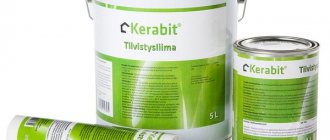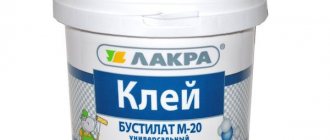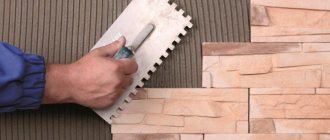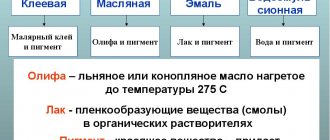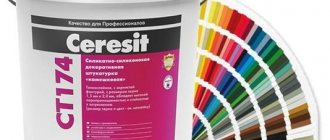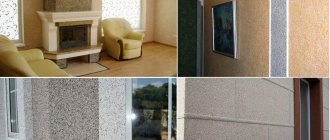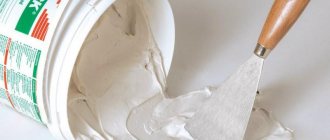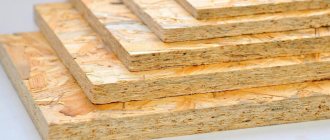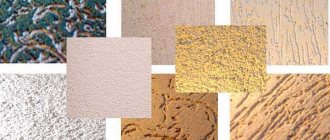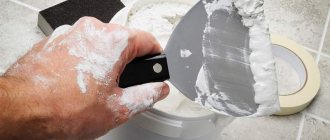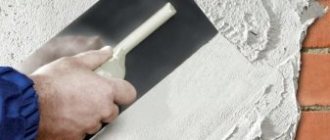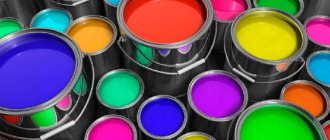Bustilat
- artificial adhesive intended for gluing wallpaper, carpeting, asbestos-cement and fiberboards, ceramic and polymer tiles, linoleum.
Developed in the 1960s by specialists from NIIMosstroy. Among the developers of the glue are Oleg Figovsky, Tamara Lavrova and Evgeny Belousov.
The composition of bustylate includes styrene-butadiene latex, chalk, carboxymethylcellulose (CMC) thickener, water, a preservative and special additives. Bustilate is a grayish-white mass of creamy consistency. Glue density is about 1.27 kg/l.
Currently, several varieties of bustilate are produced: “Bustilat-M”, “Bustilat-N”, “Bustilat-D-Super”, “Bustilat Omega”.
Application
Bustilat is intended for interior finishing work. It is used in the following cases:
- for wallpaper that is heavy and cannot be glued with paste, for gluing floor coverings, carpets, rugs;
- when gluing ceramic tiles, slopes and decorative panels;
- during the installation of borders, baseboards, parquet, parquet boards, floor tiles, for linoleum that does not have a base;
- for gluing films, leather products, polymers, PVC, suede, leatherette.
Bustilate has good adhesion, so it is often used for finishing floors, walls, and other surfaces during construction and repairs.
They can be used to glue wallpaper, install decor, and attach linoleum to stone, concrete, brick, wood, and plasterboard bases. The use of Bustilat glue is possible on fibreboard/chipboard/CBF boards.
Advantages and disadvantages
- No toxicity. Most bustylate models do not contain harmful chemicals and do not release them into the air, regardless of external conditions;
- Reliability. Over decades of use, the positive qualities of this glue have been well studied, as have the technologies for its effective use. They trust the product and know how to work with it;
- Availability and low cost. Finding boostilate in the nearest hardware store will not be difficult, but its cost, thanks to the low price of the initial components and optimization of production, is low;
- High elasticity. Even if the surfaces to be bonded are deformed, the glue, to some extent, will retain its bonding properties.
- The composition is practical. High bonding abilities allow this glue to equally effectively withstand both light wallpaper and heavy ceramic tiles. In addition, the composition can be used as a primer and waterproofing.
Important! Despite the excellent penetrating and insulating properties of the glue, if there is an alternative in the form of profile products, it is better to use it.
This glue simply does not have any serious drawbacks, showing its best side in a variety of areas of use. The only thing worth mentioning is his age. After all, over these decades, a large number of analogues have been produced, many of which may be superior to boostilate in certain indicators and be more reliable under certain operating conditions.
Compound
The glue was developed in the second half of the 20th century at the Moscow Construction Research Institute. This is a one-component latex-based mixture of creamy consistency.
The composition of the glue, in addition to latex, includes chalk, water, carboxymethylcellulose (thickener), and modifying additives. The last component gives the product optimal qualities.
The adhesive does not contain alcohol. The adhesive mixture does not contain toxic or volatile components.
Product Features
This adhesive is based on latex. This component gives the solution elasticity and practicality. The composition also contains chalk, carboxymethylcellulose, water and special additives for wear resistance, reliability and durability of the product.
The adhesive is manufactured in accordance with strict GOST standards. The product does not contain dangerous or harmful components.
The product is intended for indoor use. Work outside can only be done at a constant temperature with a plus sign.
Don't forget that the glue contains water.
Specifications
| Characteristic | Description |
| Appearance | It has a grayish-white color. When it dries, a durable transparent thin film forms at the site of application. |
| Smell | Absent |
| Consumption per 1m2 | The consumption of the product depends on the type of material to be glued. The average consumption ranges from 80 to 230 g per m2. This is a small indicator. |
| Hardening time | Bustilate dries in a maximum of 24 hours. To speed up the drying process, you need to ensure a temperature of at least 20°C. Complete adhesion to the base will occur after 36 hours. |
| Fire safety | The mixture is non-flammable because it does not contain alcohol. |
| Frost resistance | The composition contains water, so it has low frost resistance. It cannot be stored at low temperatures, but after use the frozen layer becomes insensitive to negative air temperatures. |
| Expiration date | You can store it in a closed factory container for 1 year from the date of production, which is 2 times longer than the shelf life of PVA. It should be stored in a tightly closed container, in a room with normal air humidity at a temperature of +10...+30°C. |
| Packing | Manufacturers bottle the mixture into bottles, jars and buckets of various sizes, from 1 to 18 kg. |
Storage
Bustilat glue is stored in a hermetically sealed container and in a place protected from high temperatures.
For this substance, repeated freezing (up to 5 times) with further thawing at room temperature is acceptable during transportation and storage.
Before use, the substance is thoroughly mixed.
The shelf life in the original sealed packaging at an ambient temperature of + 5-20 degrees C is 12 months from the date of manufacture.
We recommend: Tips for choosing glue for plywood and its use
Installation of floor, wall or finishing coverings indoors is not always possible with the help of fasteners. Despite the wide selection of screws, nails, bolts, studs, self-tapping screws, their presence can significantly spoil the appearance of the coating and complicate its further operation. The use of adhesives helps solve the problem. Especially appreciated are universal adhesives, suitable for gluing wallpaper and floor coverings, and placing decorative elements made of various materials. Thus, the use of Bustilat glue in the process of laying linoleum provides a high-quality coating due to a number of technical characteristics of the adhesive composition.
The domestic manufacturer offers many options for bustylate glue
Advantages and disadvantages
Advantages:
- This is an environmentally friendly, safe glue.
- Easy to use, compatible with most finishing materials, although it is more often used for gluing linoleum coverings and heavy wallpaper.
- An elastic substance with excellent adhesive ability. Bonds materials firmly and for a long time.
- It has low shrinkage and excellent adhesive properties. Due to these qualities, the adhesive provides reliable adhesion to natural and artificial surfaces. When applied, the seam is strong, elastic, and even.
- This is a multifunctional tool. Used as a primer or waterproofing compound.
- The dried product is inert to the effects of a humid environment, low and high temperatures.
- In terms of price, Bustilat is a budget mixture. This is due to cheap raw materials and optimized production.
Kinds
There are no analogues that would be similar in technical characteristics and composition. Depending on the concentration and components of the mixture, several types are distinguished.
Bustilat-M
This is a product that has increased frost resistance. It can be used inside unheated rooms and as a universal primer. More often it is used in country houses, utility rooms, and warehouses.
D-Super
It has increased adhesive properties and can easily fix thick wallpaper, finishing made of polymer materials, PVC, and carpets. Massive baseboards, cornices, and stucco molding are placed on it.
Bustilat-N
It has a classic bustylate composition, supplemented with components that increase adhesive properties. They can be used to fix surfaces with low adhesion.
The elasticity of the product does not suffer from its increased adhesiveness. It is allowed to process areas that will be subject to heavy loads during operation. When exposed to linoleum glued with Bustilat N, its fabric will not move or peel off from the base.
Omega
It is permissible to glue fabric wallpaper, linoleum, fabric, felt products or wood. Does not go deep into the surface, does not destroy the structure. There are no stains, streaks, or other imperfections that other glue can cause after drying.
Lux
Good when working with polymers. They can be used to fix siding panels, PVC film, and other finishing materials.
Varieties
Types of bustylate glue (click to enlarge)
You can find different types of glue on the market. The choice will depend on what types of work will be carried out. Below are the main types of adhesive composition.
- "Omega". This type is used for fabric or felt material. For example, it will perfectly stick fabric wallpaper to the wall. In this case, there will be no stains, since the substance will not penetrate deep into the fabric. Perfect for working with paper. It will help to glue a broken tile or a broken wooden object.
- "Bustilat-M". Capable of gluing concrete, brick, ceramics. Will withstand very low temperatures. Used when finishing tiles and wallpaper, can stick linoleum. This glue is perfect for wood. Sometimes used when priming walls.
- "Bustilat-N". It has excellent elasticity and retains its adhesive properties even when the object is deformed. Can adhere to materials that do not adhere well. For example, these include synthetic coatings.
- "Bustilat-D-super." Prevents the development of mold in the material. This adhesive can be used to attach vinyl linoleum. It is also suitable for polymer materials with a smooth surface. This substance is non-toxic and safe. There is no difference between the expensive adhesive and Bustilat-D-super. He copes well with his tasks.
- "Lux". Used for materials with a polymer base. This includes siding.
Instructions for use
Despite its environmental friendliness, before using Bustilat glue, you must first take care of the ventilation of the room.
Then you need to clean the surface to be treated from dirt, dust, and remnants of finishing materials. If you plan to treat a porous base, it is better to first coat it with a primer or a special solution.
If you intend to paste linoleum or carpet, you need to perform the following sequence of actions:
- The adhesive composition is applied to the floor in a thin layer using a spatula. Linoleum is laid on top of the glue.
- The coating is carefully pressed onto the base and left to dry completely for a maximum of 3 days.
- The consumption of the product in this case does not exceed 0.5-0.7 kg per 1 m2.
Experienced builders dilute the glue with cement mortar. This speeds up the drying of the composition when gluing linoleum or tiles. To prepare the solution, you need to take the ingredients in the following ratio: 1 part cement, 3 parts sand. And the glue and solution must be mixed in equal proportions.
If you need to glue tiles, then it is applied to the back side of the tile, and not to the wall, in a layer of 1-3 mm. After this, you need to press the tile tightly against the wall and leave it until completely dry, for a maximum of 72 hours. For such needs, the consumption varies within 0.4-1 kg per m2.
Tips for working with glue
The product must be used strictly in accordance with the instructions, which are written simply, clearly and do not require special knowledge and skills. Before using the glue, it must be mixed well, since long-term storage may cause sediment to form. It is permissible to apply the composition with any tool at the request of the master: roller, brush, spatula, cotton swab.
Surface preparation
The base must be cleaned of dirt, dust, and traces of old coating and glue must be removed. Before finishing, the walls, floor, and ceiling are leveled, puttied, sanded, and then primed. Surfaces that are too porous are treated with a special deep penetration primer. If the adhesive does not contain antifungal additives, additional application is recommended.
We recommend: Casein glue characteristics and application
Recommendations for use
Before starting work, you need to ventilate the room well. It is undesirable to use Bustilat in rooms with high humidity: despite the moisture resistance, with prolonged exposure to steam, the adhesion of the adhesive decreases. If the product has thickened, it can be diluted with water (up to 5% of the total volume).
Working with floor coverings
To glue linoleum and carpet, glue must be applied only to the floor. A thin adhesive layer (up to 3 cm) is applied with a spatula, then the flooring is laid, prepared in advance and straightened, cut to the size of the room. The material must be pressed well to the floor, rolling literally every centimeter with a roller.
The room can be used after 72 hours; during this period the glue will completely dry and gain full adhesive strength. There is another option for finishing the floor - adding cement (1:1) to Bustilat. The most durable, hard coatings can be laid on such a solution.
Laying tiles
Laying tiles on the wall can also be done using this adhesive. Apply a 2-3 mm layer to the back of the tiles using a notched trowel, press the elements against the wall, and level them. Afterwards, allow the surface to dry for 2 days (before starting active use, for example, before hanging hooks).
Wallpapering
A newly printed package of glue is used immediately, without dilution. If the product is too thick, it must be diluted with water until a homogeneous mass is obtained, reminiscent of sour cream. Next, the glue is applied to the wall or wallpaper (depending on the instructions for the specific type of wallpaper) using a brush or roller. After 10 minutes, apply the canvas to the wall, level it, carefully smooth it with a rag, rubber roller, or plastic spatula. You can open the windows in the room only every other day.
Removing old glue
If you have to remove a coating that was previously glued to Bustilat, it is important to completely free the surface of its residues. Hardened glue does not dissolve with water, so there is no point in soaking it. The easiest way is to scrape it off with a sharp spatula, scraper, or knife. The remaining product is easily separated with a grinder on which a metal brush attachment is attached.
You can also try removing the glue by heating it. First, moisten a rag with water and apply it to the contaminated area, then warm the area well with a hairdryer or iron. Heated glue is easier to remove, but the process will take quite a lot of time.
How to remove boostilate?
It is not easy to clean walls from wallpaper glued with Bustilat, since this product cannot be soaked even with hot water.
The glue can be removed mechanically. You can use a spatula, scrapers or brushes. When removing dried Bustilate, a grinder with a metal attachment is often used.
This method provokes a large emission of dust, so you need to wear a respirator.
There are traditional methods that help soften the dried composition; to do this, you need to wet a rag, apply it to the surface and iron it. The rag can be heated with a hairdryer. When the glue softens a little, it will be easier to wipe it off with a spatula.
Differences from PVA
PVA glue and Bustilat have the same scope of application. They glue the same materials together.
Both adhesives are budget-friendly, but there is a significant difference between them:
- Bustilate differs from PVA in having a longer shelf life. The first one is stored for a year, the second – for six months.
- PVA is more environmentally friendly, so it can be used for repairs in kindergartens, clinics, and educational institutions.
- The adhesive properties of Bustilat are much better than those of PVA.
Bustilat tiles
When the paint holds firmly enough, you can glue tiles onto it using bustylate, a synthetic adhesive of several types that differ in their scope of application. Bustilate is a water-based compound consisting of chalk, latex, a thickener and modifying additives that determine what materials the product is intended for gluing. The compound was developed by a domestic research institute in the 60s, but is still popular today, as it has fairly high characteristics at an affordable price.
Manufacturers
Bustilate is considered a highly sought after adhesive. Its production is established at many enterprises.
The highest quality, according to buyers, are the compositions of three manufacturers:
- "Lakra." This manufacturer produces the universal Bustilat M20. The substance is characterized by high adhesive strength, good frost resistance and water resistance. Packaged in containers of 1 and 2.5 kg.
- "Palette". The manufacturer offers glue under the name “Bustilat TURI”. It glues synthetic carpets, carpets, linoleums on a pile basis. Packaged in 1, 3, 4, 10 and 20 kg.
- "Yaroslavl colors". The product is sold in 10 and 21 kg buckets and has standard characteristics for this type of adhesive.
Bustilat from any manufacturer will help carry out high-quality repairs without overpaying for the purchase of adhesives.
